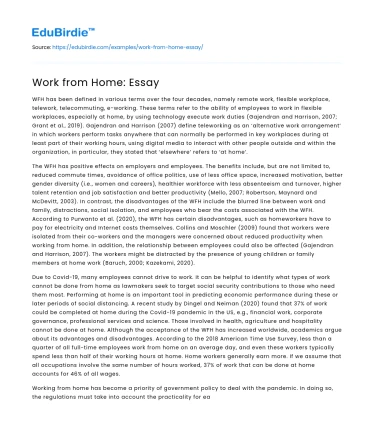WFH has been defined in various terms over the four decades, namely remote work, flexible workplace, telework, telecommuting, e-working. These terms refer to the ability of employees to work in flexible workplaces, especially at home, by using technology execute work duties (Gajendran and Harrison, 2007; Grant et al., 2019). Gajendran and Harrison (2007) define teleworking as an ‘alternative work arrangement’ in which workers perform tasks anywhere that can normally be performed in key workplaces during at least part of their working hours, using digital media to interact with other people outside and within the organization, in particular, they stated that ‘elsewhere’ refers to ‘at home’.
The WFH has positive effects on employers and employees. The benefits include, but are not limited to, reduced commute times, avoidance of office politics, use of less office space, increased motivation, better gender diversity (i.e., women and careers), healthier workforce with less absenteeism and turnover, higher talent retention and job satisfaction and better productivity (Mello, 2007; Robertson, Maynard and McDevitt, 2003). In contrast, the disadvantages of the WFH include the blurred line between work and family, distractions, social isolation, and employees who bear the costs associated with the WFH. According to Purwanto et al. (2020), the WFH has certain disadvantages, such as homeworkers have to pay for electricity and Internet costs themselves. Collins and Moschler (2009) found that workers were isolated from their co-workers and the managers were concerned about reduced productivity when working from home. In addition, the relationship between employees could also be affected (Gajendran and Harrison, 2007). The workers might be distracted by the presence of young children or family members at home work (Baruch, 2000; Kazekami, 2020).
Save your time!
We can take care of your essay
- Proper editing and formatting
- Free revision, title page, and bibliography
- Flexible prices and money-back guarantee
Due to Covid-19, many employees cannot drive to work. It can be helpful to identify what types of work cannot be done from home as lawmakers seek to target social security contributions to those who need them most. Performing at home is an important tool in predicting economic performance during these or later periods of social distancing. A recent study by Dingel and Neiman (2020) found that 37% of work could be completed at home during the Covid-19 pandemic in the US, e.g., financial work, corporate governance, professional services and science. Those involved in health, agriculture and hospitality cannot be done at home. Although the acceptance of the WFH has increased worldwide, academics argue about its advantages and disadvantages. According to the 2018 American Time Use Survey, less than a quarter of all full-time employees work from home on an average day, and even these workers typically spend less than half of their working hours at home. Home workers generally earn more. If we assume that all occupations involve the same number of hours worked, 37% of work that can be done at home accounts for 46% of all wages.
Working from home has become a priority of government policy to deal with the pandemic. In doing so, the regulations must take into account the practicality for each employer and each staff both part-time and full-time workers, as some effects can arise for both groups in the same situation.






 Stuck on your essay?
Stuck on your essay?

